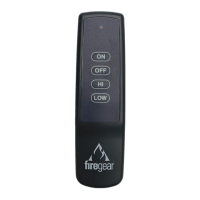Revised 3/17/05 Page 4 of 5
OPERATION
1. This remote control will operate the AF-2000 gas control valves ON/OFF and flame height HI/LO of the main burner.
2. When the ON button is depressed the transmitter sends a RF signal to the receiver. The receiver
then sends a pulse of 3 volts of power to the internal solenoid. The internal solenoid then opens the gas flow
to the main burner ON at HI flame.
PULSE POWER
3. When the LO button is depressed the transmitter sends a RF signal to the receiver. The receiver then sends a
pulse of 3 volts of power to the HI/LO solenoid. The HI/LO solenoid then reduces the gas flow to the burner (LO flame).
4. When the HI button is depressed the transmitter sends a RF signal to the receiver. The receiver then sends a
pulse of 3 volts of power to the HI/LO solenoid. The HI/LO solenoid then increases the gas flow to the burner (HI flame).
CONTINUOUS POWER
5. When the LO button is depressed the transmitter sends a RF signal to the receiver. The receiver then sends a
continuous 3 volts of power to the HI/LO DC motor drive. The HI/LO DC motor drive then reduces the gas flow to the burner.
6. When the HI button is depressed the transmitter sends a RF signal to the receiver. The receiver then sends a
continuous 3 volts of power to the HI/LO DC motor drive. The HI/LO DC motor drive then increases the gas flow to the burner.
7. When the OFF button is depressed the transmitter sends a RF signal to the receiver. The receiver then sends a
pulse of 3 volts of power to the internal solenoid. The internal solenoid then closes the gas flow to the main burner OFF.
8. The remote control will only work with the hand held transmitter. The receiver slide switch is only for positive OFF or REMOTE
operation.
NOTE: The RCAF-2 system will always default to HI flame after the system has been shut down. When the system is turned back
ON the flame will come on at HI flame.
BATTERY LIFE
Life expectancy of the alkaline batteries in the RCAF-3 can be up to 12 months depending on use of the solenoid function. Check and
replace all batteries annually. When the transmitter no longer operates the remote receiver from a distance (i.e., the transmitter's range
has decreased) or the remote receiver does not function at all, the batteries should be checked. It is important that the remote receiver
batteries are fully charged, providing combined output voltage of at least 5.0 volts. The transmitter should operate with as little as 9.0
volts battery power.
TROUBLE SHOOTING
If you encounter problems with your fireplace system, the problem may be with the appliance itself or it could be with the RCAF-3
remote system. Review the appliance manufacturer's operation manual to make sure all connections are properly made. Then check
the operation of the remote in the following manner:
1. Make sure the batteries are correctly installed in the RCAF-3. One reversed battery will keep RCAF-2 from operating properly.
2. Check the (2) pin connector at the AF-2000 gas control valve that it is making good connection.
3. Check the ON / AUX knob on the AF-2000 to make sure that it is in the (AUX) position and not in (ON) position.
4. Check the 1/4” terminals on the HI/LO solenoid or DC motor drive for proper connection.
5. If the RCAF-3 is hearth mounted keep Hearth switch from temperatures exceeding 120° F. Battery life is shortened when ambient
temperatures are above 120° F.
NOTE:
1. A receiver located in an area, where the ambient temperature inside the case exceeds 130° F, will cause the THERMO-SAFETY
feature to cut in, requiring you to reposition the receiver to stop the warning beeps, and to "reset" the receiver's operation.
2. Due to handling and shipping of the unit, handling or dropping of the transmitter by the customer, and/or heat conditions at the
receiver, some receivers may need an occasional frequency adjustment. This adjustment is made to improve the communication
and operating distance between the transmitter and the receiver. Follow the steps below for making the adjustment.
f i r e - p a r t s . c o m

